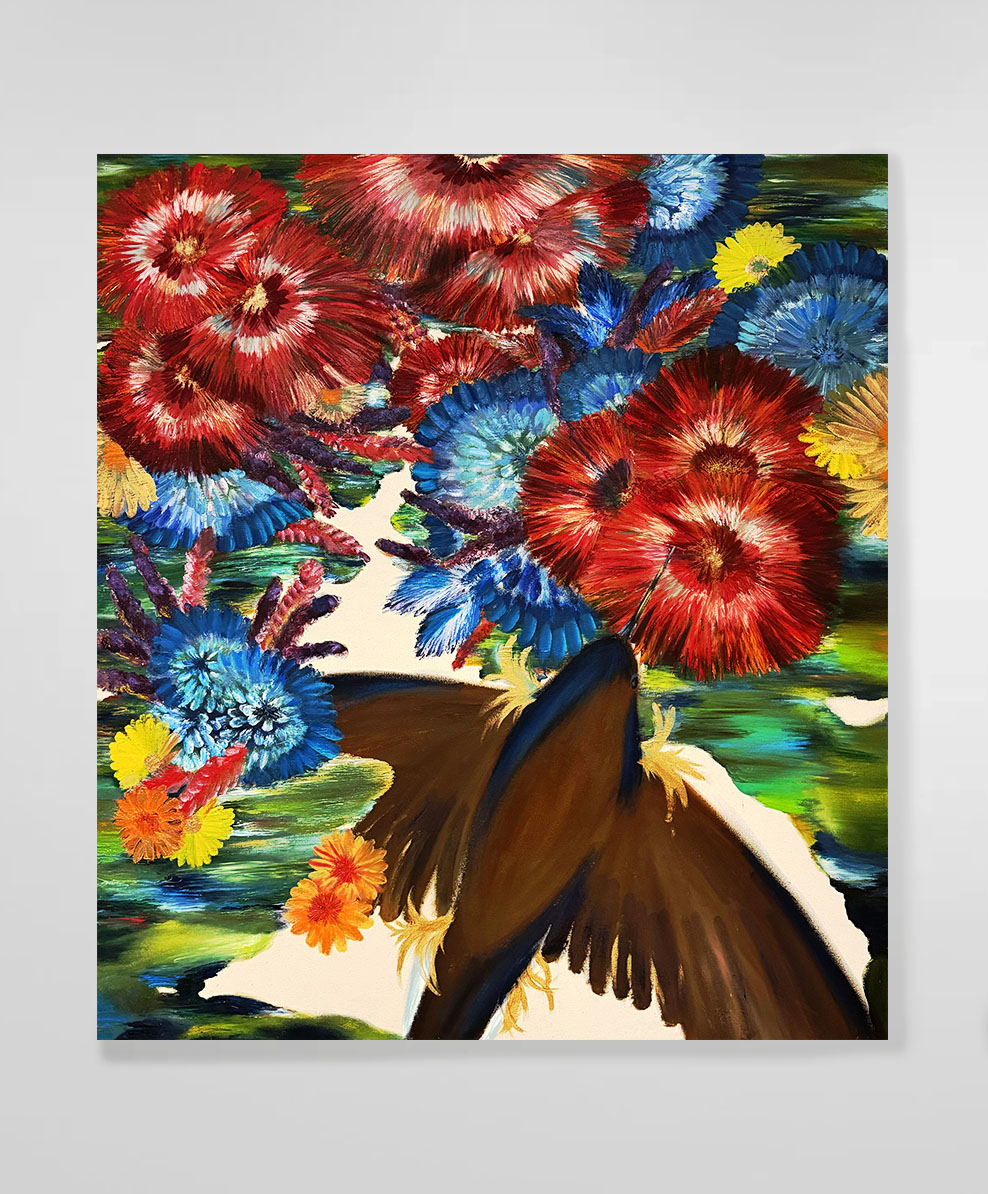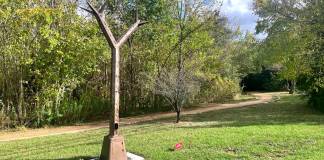To encounter Yula’s work is to step into a dream just before waking, when forms blur, meanings flicker, and presence hovers on the edge of becoming. Her canvases hum with life, not in obvious declarations, but in murmurs and fragments: a wing just out of frame, the hush of feathers lost to time, a blue bloom that may be flower, or flame, or memory.
This is painting as an invocation. With oil, natural pigments, and layered textures, Yula doesn’t paint what she sees, she paints what slips away. Her surfaces carry the weight of both the seen and the forgotten, where colour moves like breath and silence interrupts the composition like an unanswered question. Somewhere between abstraction and figuration, her work dwells in the in-between: not undecided, but deliberately unresolved.
In Yula’s work, birds appear often not as specimens, but as ghosts, as alter egos, as weather vanes of change. Their presence is no accident. In 2017, during a formative stay in Hawai‘i, Yula stood before a traditional Hawaiian feather cloak, a radiant ʻahu ʻula made of red and yellow plumage. It was a moment of quiet revelation. The cloak held a sacred charge but also echoed a loss that transcended language. It was here that art, ecology, and cultural memory converged for her, and that convergence would become the heart of her practice.
Years later, her postgraduate studies at the Royal College of Art and University College London deepened this inquiry. Yula’s visual language was sharpened not only through the studio but through fieldwork, quiet hours in museum basements, examining endangered and extinct birds preserved in taxidermy collections from the UK to the United States. She studied them not just as forms, but as symbols of fragility, of reverence, of colonial legacy and ecological erasure.

Her collaborations with the Zoological Society of London (ZSL), where she joined curatorial and educational research efforts as part of a formal academic placement, added yet another layer: the scientific. During her time there, she investigated the curatorial order of animals and the pathways people take when learning through observation through studying how spatial choices, such as the placement of animal displays and accompanying informational panels, influence understanding. Here, art did not stand apart from zoology or philosophy, it became the bridge, the interpreter, the voice between disciplines. The result is work that feels as informed as it is intuitive, rooted in scholarship but pulsing with sensation.
In The One: A Vast Blue Bloom and Birds Never Seen (2025) painting, a vast, electric-blue bloom pulses at the center; its radiating strokes applied in densely layered fans, creating a bristling, halo-like form that feels both floral and planetary. The brushwork is deliberate, almost meditative, each mark catching light and breaking shadow. Around it, scattered circles and blurred petals flicker between abstraction and organic detail. The paint thickens and thins across the canvas, some areas scraped back, others glowing with impasto.
A dark, partial bird enters from below, rendered with glazes and feathered edges, barely disrupting the rhythm. The creature appears caught in a moment of stillness, its gesture ambiguous: is it arriving, or leaving? Here, Yula blurs movement and stillness, visibility and memory. It is not a painting that asks to be understood. It invites to feel your way through the tension of beauty and loss.


In Bio-Synthetic Symphony (2025), the canvas blooms in full chorus. Clusters of red, yellow, orange, and midnight blue flowers press forward from all directions, painted with tightly packed, radial strokes that echo both natural petals and obsessive repetition. The surface is vibrant and pulsing, with textures layered thickly in some areas, feathered in others, creating a rhythm that feels alive, swelling, almost overgrown.
Amid this floral abundance, the form of the extinct ʻōʻō bird emerges, but only partially, as if overwhelmed by its environment or half-consumed by time. Painted in deep, smooth tones, its presence is both reverent and restrained. Here, Yula’s brushwork doesn’t isolate the subject from setting. It lets the bird and blossoms blur together, as if nature, memory, and extinction were part of the same unstoppable bloom. The result is both celebratory and elegiac, a vision of life at its most lush, but also at its most fragile.


Phantom Reverie (2024), though painted before Bio-Synthetic Symphony (2025) and The One: A Vast Blue Bloom and Birds Never Seen (2025), feels like the beginning of the end. Here, the bird is no longer elusive. It reveals itself in full form, its entire body rendered and enclosed within a rigid pink square, as if awaiting classification. It appears ready to be catalogued, boxed, recorded, prepared not for flight, but for preservation in a book, a museum, a memory. The floral elements that once surrounded it, the organic backdrop of its ecosystem, are now fading beneath those pink grids. Yet the surface resists stillness. The paint is heavier, the texture thicker, almost restless. Nature pushes back, blurry petals and leaves stretch outward as if trying to escape the frame, as if refusing to be stilled. The painting becomes a quiet struggle between containment and vitality, between documentation and life. It holds a quiet violence: a creature stilled for observation, while the world it belonged to strains to escape confinement. Here, texture becomes metaphor, the vitality pressing against the limits of order.
They offer a kind of trust that beauty and grief can share the same skin, that the act of looking might still carry meaning, even now. In a time when much of the world is in retreat from stillness, the artist’s practice insists on it. It asks us to pause, not to solve. And in that pause, something stirs, soft as wings, sharp as memory, vital as breath.
Yula invites us to look, not just with the eyes, but with something slower, older. With attention. With care. These works don’t offer a resolution.
Great Job Sophie Nowakowska & the Team @ Our Culture Source link for sharing this story.





